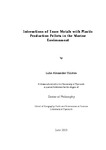Interactions of Trace Metals with Plastic Production Pellets in the Marine Environment
| dc.contributor.supervisor | Turner, Andrew | |
| dc.contributor.author | Holmes, Luke Alexander | |
| dc.contributor.other | School of Geography, Earth and Environmental Sciences | en_US |
| dc.date.accessioned | 2013-08-05T10:37:59Z | |
| dc.date.available | 2013-08-05T10:37:59Z | |
| dc.date.issued | 2013 | |
| dc.identifier | 10011498 | en_US |
| dc.identifier.uri | http://hdl.handle.net/10026.1/1593 | |
| dc.description.abstract |
This study investigates the interactions between dissolved trace metals and plastic debris under controlled laboratory conditions by using polyethylene pellets as a model plastic particle. Specifically, the study compared virgin pellets sourced from a local moulding plant with those collected from local beaches and subjected to aging, attrition and deposition of extraneous material. Pellets collected from the coastline of Southwest England were mainly polyethylene according to Fourier transform infra-red spectroscopy (FTIR), although occasional polypropylene pellets were present. Additionally, FTIR was used to identify the extent of degradation of pellets according to a photo-oxidation index derived from the relative magnitudes of specific absorbance peaks, and suggests pellet colour may give an indication of polymer degradation. Acid extractions of pellets collected from the coastline of Southwest England yielded metal concentrations ranging from low ng g-1 for metals such as Cd, Ni and Cr, to 7.7, 10.3 and 290 g g-1 for Cu Pb and Zn, respectively, while Al, Fe and Mn were present on beached pellets at concentrations of up to 171, 314 and 308 g g-1, respectively. Metal concentrations exhibited a high degree of inter- and intra-site variability. Correlation of metal concentrations with the photo-oxidation index indicates that pellet age is not a reliable indicator of metal concentrations. Batch experiments where metals (Cd, Co, Cr, Cu, Ni, Pb, Zn) were added to suspensions of pellets in seawater and estuarine water were performed in order to understand the extent and rates of trace metal adsorption to pellets. Langmuir modelling of adsorption isotherms in seawater indicated a range of maximum values for the accumulation of trace metals on beached pellets from 10 ng g-1 to 720 ng g-1 for Cd and Pb, respectively, in seawater spiked with 5 g L-1 of each trace metal. Langmuir constants for these relationships ranged from 0.140 (Cd) to 2.67 (Ni) mL g-1. Differences between trace metal affinities for pellets collected from the environment (beached) and those obtained directly from a plastics processing facility (virgin) were also identified. Adsorption maxima for virgin pellets ranged from < 1 ng g-1 (Cd) to 300 ng g-1 (Cr) with corresponding, respective Langmuir constants of 0.413 and 0.127 mL g-1. Adsorption of trace metals to beached pellets exceeds that to virgin pellets owing to the development of viable surface sites by photo-oxidation, biofouling and deposition of fine sediment particles on the former during exposure to environmental conditions. Adsorption kinetics were modelled successfully using a pseudo first-order reversible model. Chemical response times derived from kinetic constants ranged from 1.5 – 12 h for beached pellets and 0.2 to 4.5 h for virgin pellets, and were generally lower in seawater than in river water. Applying a similar batch approach to a system simulating an estuarine salinity gradient, the controlling effects of ionic strength and pH on the adsorption of trace metals to pellets were identified. Partitioning of Cd, Co and Ni exhibited inverse relationships with salinity, with partition coefficients (KD) decreasing from values of the order 101 to 10-1 or 10-2 mL g-1 (for beached pellets) as salinity is increased from < 0.05 to 33. Chromium exhibited contrasting behaviour within the estuarine gradient, with partitioning increasing with salinity, while Pb appears to be independent of salinity within this system. Chemical modelling was used to explain the results in context of changes in trace metal speciation which occur through the estuarine gradient. The bioaccessibility of metals on beached pellets to avian species was determined using an in vitro approach. Metal bioaccessibility in a simulated avian gastric environment comprising 10 g L-1 pepsin, 0.1 M NaCl and HCl at pH 2.8 indicated metals on pellets are labile (bioaccessibility ranges from < 10 % (Cr) to > 80 % (Mn)) and may be released readily within the digestive tract. Dissolution kinetics were modelled using the Noyes-Whitney equation, from which rate constants were determined in the range 3.1 x10-4 (Cr) to 8.7 x10-1 %-1 h-1 (Mn). This study has shown, for the first time, that plastic pellets have the potential to accumulate and transport trace metals in the marine environment. Furthermore, metal accumulation on plastic pellets is controlled by estuarine master variables such that conditions which favour or limit adsorption can be defined. Pellets present a previously unreported vector for the transport of metals in the environment, and have the potential to convey metals to organisms upon ingestion. The findings of this thesis have implications for interactions between metals and plastics more generally in the marine environment. | en_US |
| dc.language.iso | en | en_US |
| dc.publisher | University of Plymouth | en_US |
| dc.subject | Plastic | en_US |
| dc.subject | Adsorption | en_US |
| dc.subject | Kinetics | en_US |
| dc.subject | Trace metals | en_US |
| dc.subject | Seawater | en_US |
| dc.subject | Estuarine | en_US |
| dc.subject | Bioaccessibility | en_US |
| dc.title | Interactions of Trace Metals with Plastic Production Pellets in the Marine Environment | en_US |
| dc.type | Thesis | en_US |
| plymouth.version | Edited version | en_US |
| dc.identifier.doi | http://dx.doi.org/10.24382/1332 |
Files in this item
This item appears in the following Collection(s)
-
01 Research Theses Main Collection
Research Theses Main


